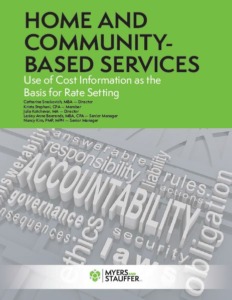In a series of posts, Myers and Stauffer will highlight home and community-based services (HCBS) and rate setting methodologies that can have a tremendous impact on services with state programs.
An important element in designing and collecting cost data is the inclusion of the stakeholder community. While the stakeholder group with the greatest level of involvement is usually the provider community and its representatives, states should not neglect to consider individuals who receive services, their family members, and representatives of state legislative bodies.
Communication with stakeholders is a vital part of the cost-survey collection process, from designing the survey itself, to resolving issues about cost collection, to understanding the survey data after it has been collected and analyzed. Stakeholders can provide valuable insight into the delivery of services and the best ways to obtain cost information. Agency staff are not always aware of the nuances in service delivery. Discussions between agency staff and providers can clarify these specifics. Work groups can be implemented effectively and can serve as sounding boards in the design of cost surveys that are most reflective of provider needs.
States should consider which stakeholders can provide technical information about costs and how to report that cost data along with practical information about service delivery. Different stakeholders may be involved at different times during the project. Those with financial management responsibilities can best identify elements of cost information to obtain, and those with operational responsibilities can provide information about service delivery. A combination of these individuals can help interpret and understand data the survey yields.
An effective stakeholder communication strategy will be a key component of the cost survey, cost analyses, and later rate-development process.
How We Can Help
Myers and Stauffer works with states to develop effective internal and external Medicaid stakeholder communication strategies to support the development of new policies and procedures. We have executed these strategies to help states evaluate rate methodologies and make recommendations for new ones that improve the access and quality of HCBS.
Although no two Medicaid programs are exactly alike, our nationwide experience enables us to draw upon best practices to address specific Medicaid stakeholder issues and concerns. Specifically, our approach to facilitating stakeholder engagement consists of the following three steps:
Step 1: Stakeholder Identification
Any change in HCBS rate-setting methodologies will affect a number of people with different and sometimes competing goals and objectives. Stakeholders may include cross-disability representation of individual participants as well as community, provider, and advocacy groups to obtain meaningful input into both planning and operation. To ensure states receive input from a variety of stakeholders Myers and Stauffer will review priorities, objectives, and timelines; discuss expectations regarding the level and scope of stakeholder engagement; and identify key stakeholder groups and points of contact for each.
Step 2: Stakeholder Communications
In our experience, the more open the communication by the state, the more likely it is for stakeholders to participate actively in the process and support the rate-setting changes. We work with each state to determine key points throughout the rate-setting process to communicate current developments to affected parties and solicit input about what methodologies are most valued and by whom. We are also able to respond to stakeholder questions throughout the project by publishing documents such as frequently asked questions, status updates, participation in webinars, or through direct contact such as meetings.
Step 3: Stakeholder Participation
Stakeholders may be actively engaged throughout the rate-setting process in a number of ways, including: the periodic issuance of project status reports; holding one or more stakeholder meetings to solicit input on specific aspects of the rate-setting methodologies under consideration; potential performance of one or more site visits to evaluate stakeholder processes; and participation in stakeholder surveys to gather data and other information. We are also prepared to hold town hall meetings with stakeholders, which can provide a relaxed, non-threatening forum for interviewing concerned caregivers, consumers, and providers to gather information on the rate-setting process, data collection, and potential methodologies.
For more information, please contact us.
| Krista Stephani, CPA
Member PH 208.685.1569 PH 800.336.7721 |
Lesley Beerends, MBA, CPA
Senior Manager PH 816.847.3280 PH 800.374.6858 |



